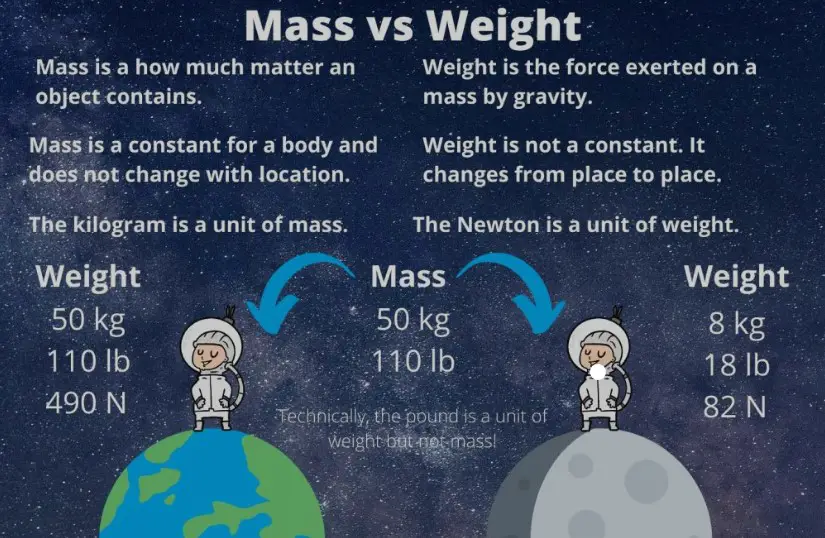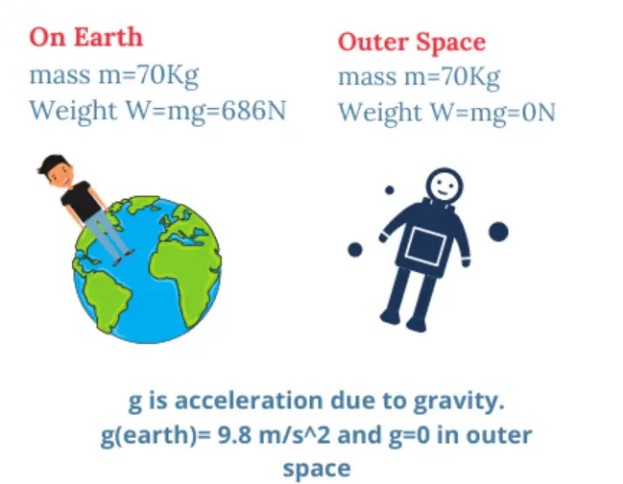Mass and weight are fundamental concepts in physics, yet they are often used interchangeably in everyday language, leading to confusion. While both properties relate to physical objects and are crucial in various scientific and engineering disciplines, they represent different physical quantities. This distinction is not just academic; it has practical implications in fields ranging from materials science to aerospace engineering.
The relation between mass and weight is straightforward yet profound: mass is a measure of the amount of matter in an object, a constant value regardless of location, while weight is the force exerted by gravity on that mass, which can vary based on where the object is in the universe. Essentially, weight is the result of gravity acting on mass.
Understanding this relationship is key to grasping the principles of physics that govern our world. From the way we measure our own weight to how astronauts experience weightlessness in space, the distinction between mass and weight touches on many aspects of daily life and scientific inquiry. It’s a fundamental concept that bridges the gap between the tangible and the theoretical, providing insights into the very fabric of the universe.

Mass Explained
Definition
At its core, mass is a measure of the amount of matter in an object. Unlike weight, which can change based on an object’s location (due to gravity), mass is a constant property. It does not change whether an object is on Earth, the Moon, or floating in the depths of space. Mass is a fundamental concept in physics, serving as a cornerstone for various laws and principles governing the physical world.
How Mass Is Measured
Measuring mass involves quantifying the amount of matter in an object. Here are some common methods used:
- Balancing Scales: A well-known tool for measuring mass. An object’s mass is compared against a set of standard weights until equilibrium is reached.
- Spring Scales (for educational purposes): These measure force but can be calibrated to indicate mass by taking gravity into account.
- Mass Spectrometry: A highly precise method used in chemistry and physics to determine the mass of particles and molecules.
The unit of mass in the International System of Units (SI) is the kilogram (kg).
Constant Across the Universe
One of the most fascinating aspects of mass is its constancy. No matter where an object is located in the universe:
- Its mass remains the same.
- This constancy makes mass a key property for scientific studies, independent of location or gravitational influence.
Weight Unveiled
Definition
Weight is often confused with mass, but they are not the same. Weight is the force that gravity exerts on an object’s mass. Unlike mass, weight is a vector, meaning it has both magnitude and direction. The direction is always towards the center of the object exerting the gravitational pull, such as the Earth.
How Weight Is Measured
Weight is measured by calculating the force with which gravity pulls on an object. Here’s how:
- Spring Scales: Measure the force of gravity on an object. The scale measures weight directly by showing how much the spring stretches under the object’s weight.
- Digital Scales: Use sensors to measure the force of gravity and display an object’s weight electronically.
Weight is measured in newtons (N) in the SI system, though kilograms are often used for convenience on Earth, implicitly referring to the weight under Earth’s gravity.
Varied by Gravitational Pull
An object’s weight changes based on the gravitational pull it experiences, which can vary by location:
- On the Moon, an object weighs about one-sixth of its Earth weight.
- In space, far from significant gravitational pulls, an object can be weightless, though its mass remains unchanged.
Core Differences
Mass vs. Weight Comparison
Understanding the difference between mass and weight is crucial. Here’s a concise comparison:
- Mass:
- Scalar quantity (has magnitude only).
- Measured in kilograms.
- Constant regardless of location.
- Weight:
- Vector quantity (has magnitude and direction).
- Measured in newtons.
- Changes with the gravitational field strength.
Influence of Gravity on Both
Gravity plays a central role in differentiating mass and weight:
- Gravity’s Effect on Mass: None. Mass is intrinsic to the object.
- Gravity’s Effect on Weight: Direct. Weight is the result of gravity acting on mass.
Understanding this relationship helps clarify why astronauts appear weightless in space. Their mass hasn’t changed; the gravitational force exerted on them is just much weaker.

Scientific Principles
Newton’s Second Law of Motion
Newton’s Second Law of Motion is pivotal in understanding how motion occurs when a force acts upon a mass. The law states that the acceleration of an object is directly proportional to the net force acting on the object and inversely proportional to its mass. This principle can be succinctly expressed as �=��F=ma, where �F is the net force applied to the object, �m is the mass of the object, and �a is the acceleration.
This law explains why different masses accelerate at different rates under the same force and is fundamental in calculating an object’s weight, which is a force (weight = mass × gravity).
Gravitational Force and Its Impact
Gravitational force is the attraction between two masses. Its impact is universal, affecting everything from the tiniest particles to the largest galaxies in the universe. The force of gravity depends on the masses of the objects and the distance between them, formulated by Newton’s Law of Universal Gravitation.
Gravitational force is responsible for:
- Keeping planets in orbit around stars
- Influencing tides on Earth due to the Moon’s gravity
- Determining the weight of objects
Measurement Techniques
Tools for Measuring Mass
Mass is measured using various tools, depending on the precision required and the context:
- Balances: Compare an unknown mass to known masses.
- Spring Scales (calibrated for mass measurement): Used in educational settings.
- Mass Spectrometers: For particle physics and chemistry, offering high precision.
Tools for Measuring Weight
Weight measurement tools calculate the force of gravity on an object:
- Spring Scales: Measure the force directly by the extension of the spring.
- Digital Scales: Use electrical resistance changes in response to weight, providing a digital readout.
- Balances: In a known gravitational field, can be used to infer weight by measuring mass.
Conversion Between Mass and Weight
To convert between mass and weight, the formula �=��W=mg is used, where:
- �W is weight in newtons,
- �m is mass in kilograms,
- �g is the acceleration due to gravity (approximately 9.81�/�29.81m/s2 on Earth).
This conversion is crucial in many scientific and engineering calculations, enabling the appropriate analysis of forces.
Practical Applications
Everyday Examples
The principles of mass and weight influence daily activities such as:
- Cooking: Measuring ingredients by mass for accuracy.
- Health: Using scales to monitor body weight, reflecting the gravitational pull on one’s mass.
- Transportation: Calculating load weights for vehicles to ensure safety and efficiency.
Scientific Research
In scientific research, understanding mass and weight is fundamental for:
- Chemistry: Measuring reactants and products accurately.
- Physics: Studying forces, motion, and the properties of matter.
- Astronomy: Calculating gravitational forces to understand celestial movements and interactions.
Space Exploration Insights
Space exploration has provided unique perspectives on mass and weight:
- Microgravity: In orbit, astronauts experience weightlessness, though their mass remains unchanged. This environment is crucial for experiments that require conditions free from Earth’s gravity.
- Planetary Landings: Understanding the gravitational pull of other planets is vital for the safe landing and operation of spacecraft.
- Rover Operations: Mars rovers, for example, are designed considering the Martian gravity, which affects their weight and thus, their mobility and energy consumption.
Frequently Asked Questions
What exactly is mass?
Mass is a property of physical objects that quantifies the amount of matter they contain. It is a scalar quantity, meaning it has magnitude but no direction, and remains constant regardless of the object’s location in the universe. Mass is a fundamental measure in physics, influencing how objects interact with forces, including gravitational pull.
How does gravity affect weight?
Gravity is the force that attracts two bodies towards each other. Weight, defined as the force of gravity acting on an object’s mass, varies with the strength of the gravitational field it is in. This means an object’s weight is less on the Moon than on Earth due to the Moon’s weaker gravitational pull, despite the object’s mass remaining unchanged.
Can weight be zero?
Weight can indeed be zero, but only in conditions where there is no gravitational pull acting on an object, such as in deep space. This state is often referred to as weightlessness. However, even in these conditions, the mass of the object remains unchanged, highlighting the distinction between mass and weight.
Why do astronauts float in space?
Astronauts float in space because they are in a state of constant free fall towards Earth, creating the sensation of weightlessness. This occurs because the spacecraft and the astronauts inside are both being pulled by Earth’s gravity at the same rate, effectively canceling out the force of gravity inside the spacecraft.
Conclusion
Understanding the difference between mass and weight is more than an academic exercise; it’s a window into the fundamental principles that govern the universe. This distinction helps us make sense of everything from the daily weather forecast to the cutting-edge research conducted on the International Space Station. By appreciating the nuances of these concepts, we can better understand our world and the broader cosmos.
In conclusion, the relation between mass and weight is a fundamental concept that highlights the interaction between matter and gravity. Recognizing this relationship not only enriches our understanding of the physical world but also underscores the importance of precision in scientific language and thought. As we continue to explore beyond our planet, this understanding becomes ever more crucial in navigating the challenges and opportunities of the universe.

